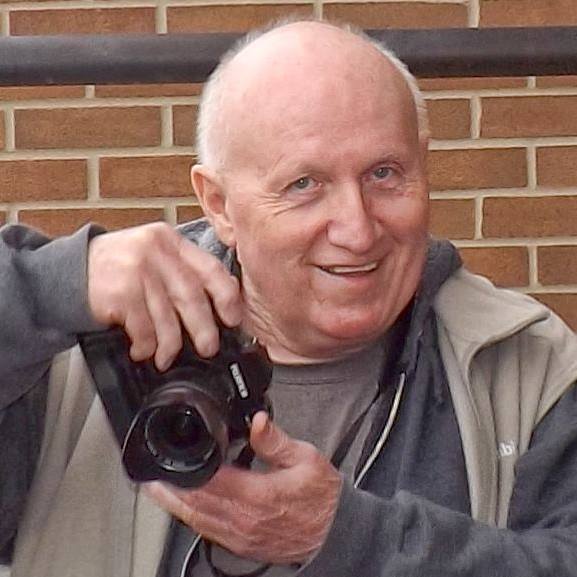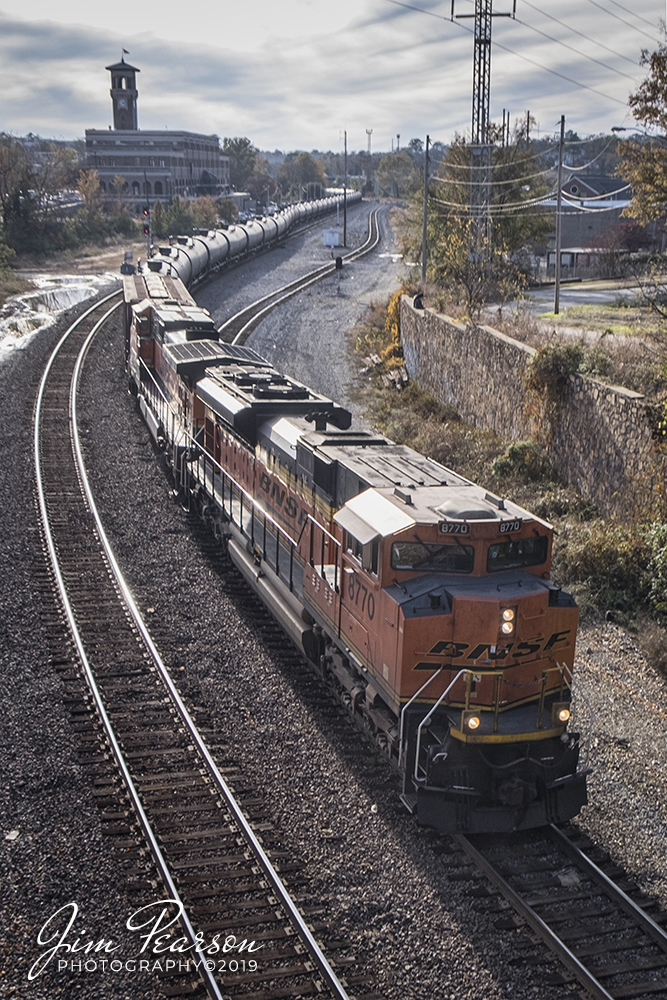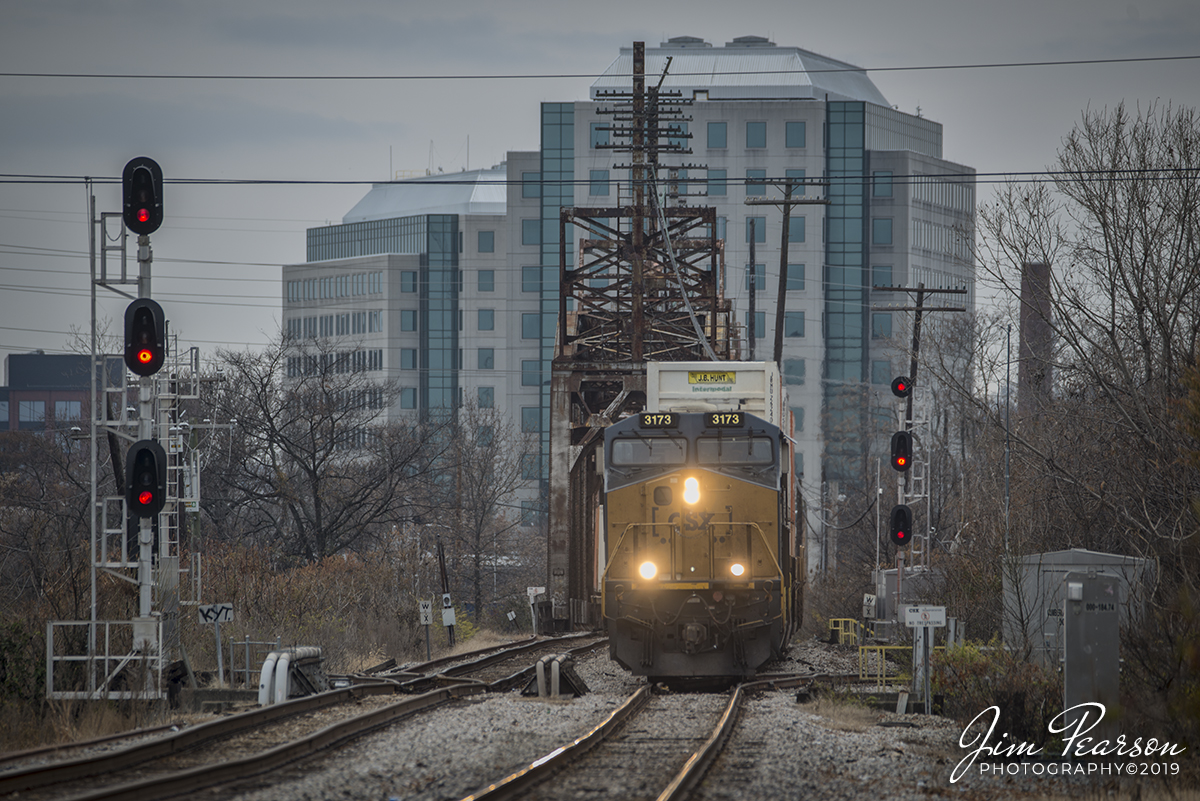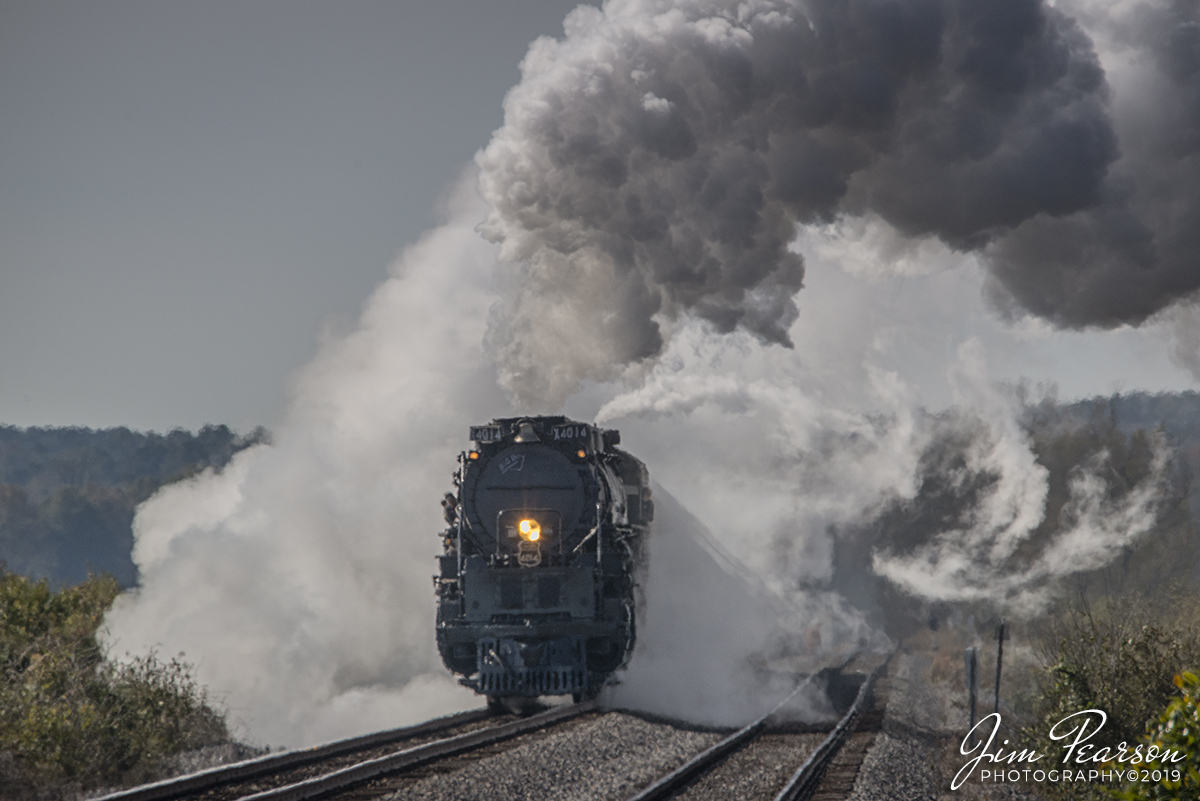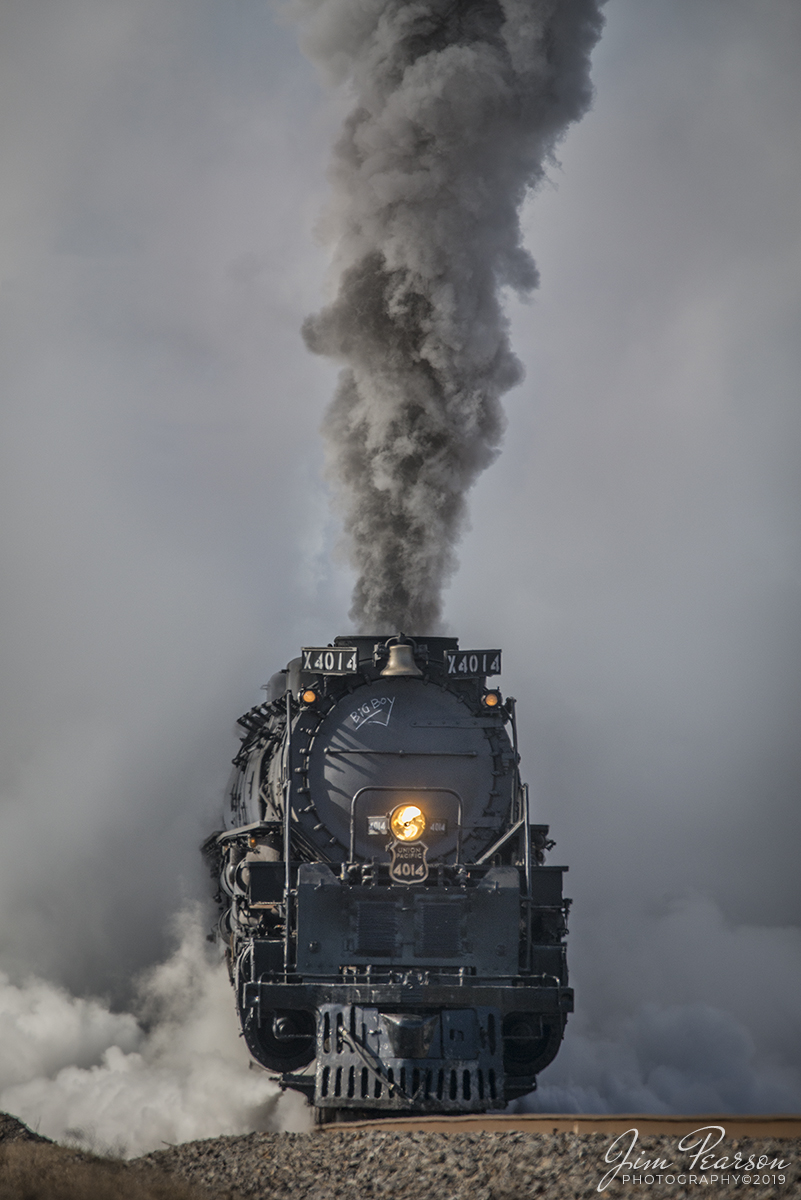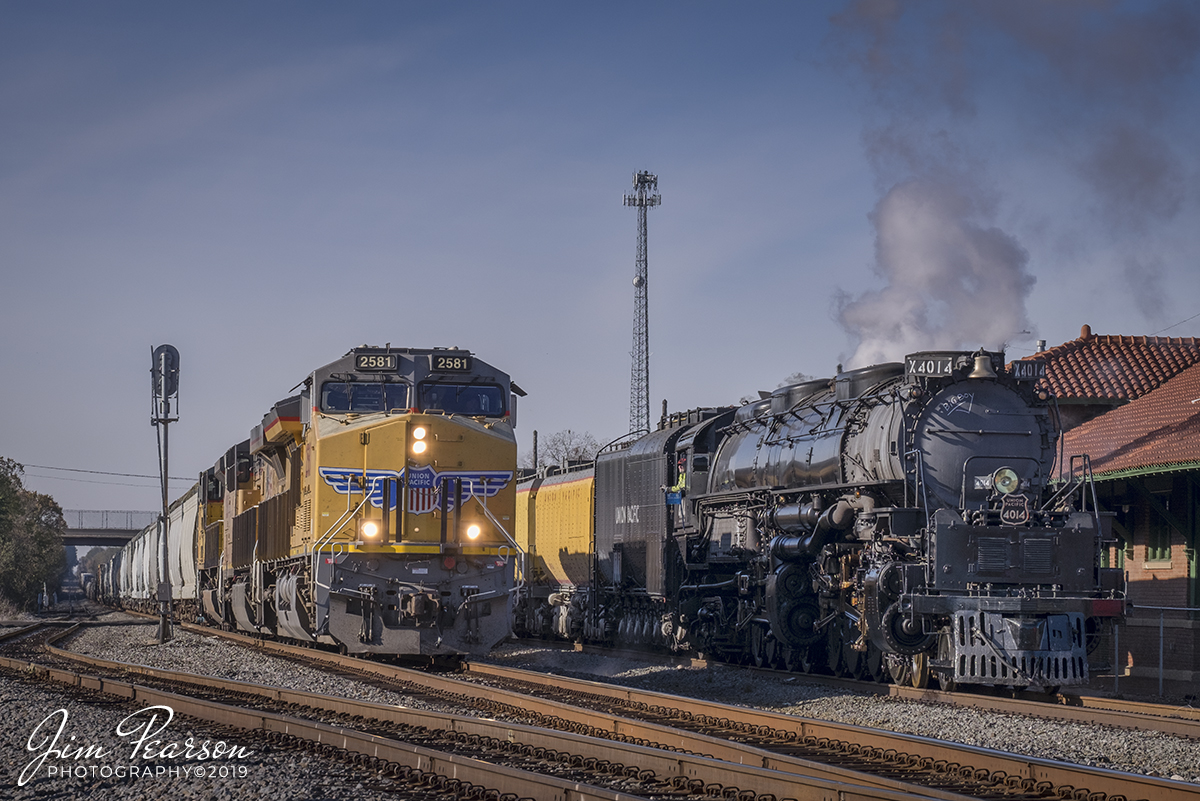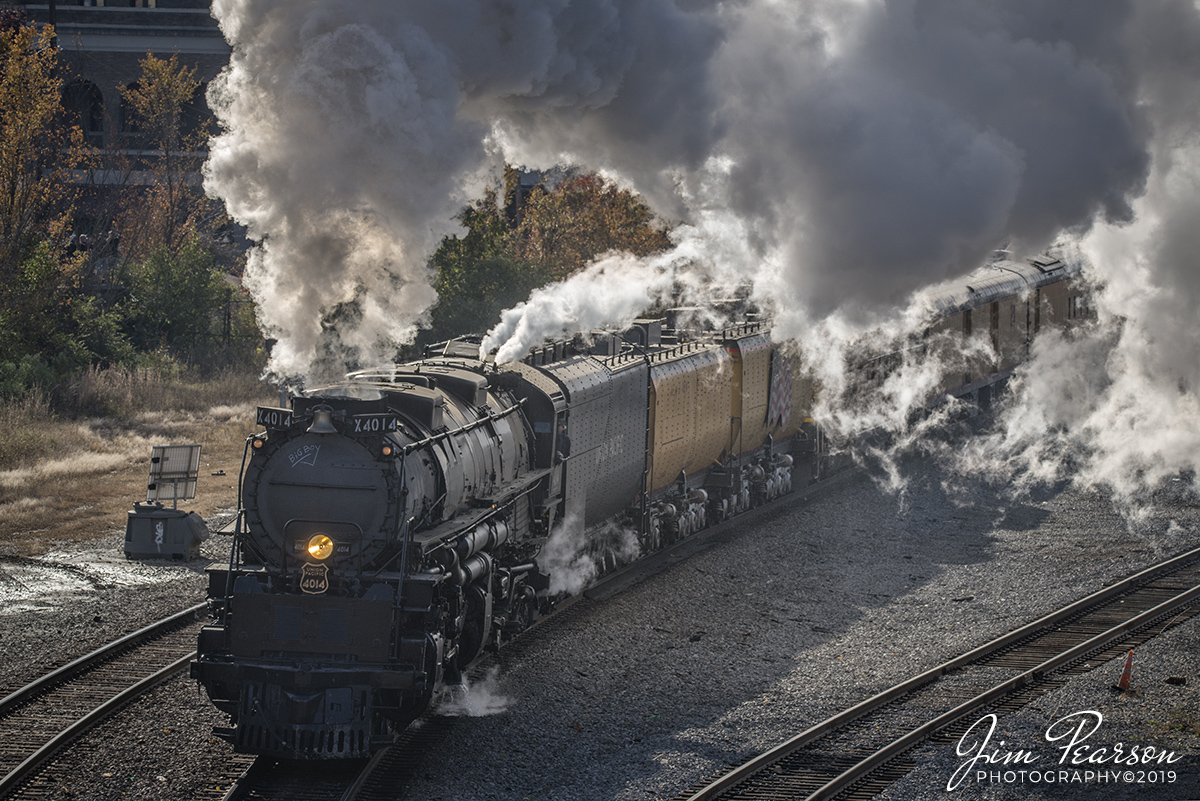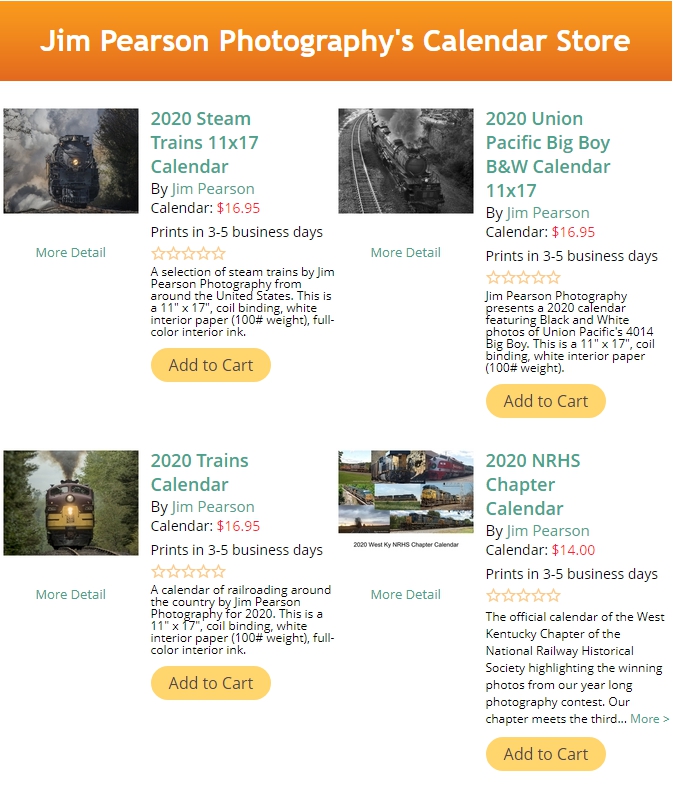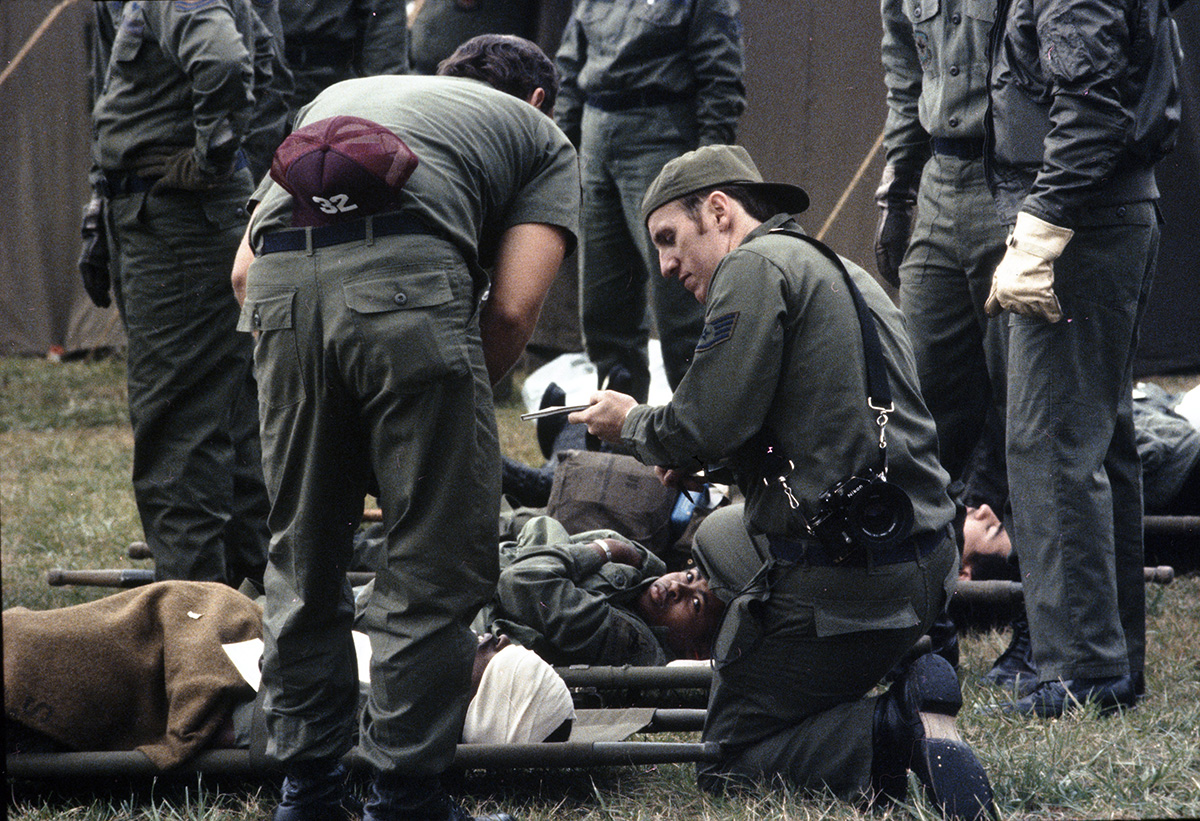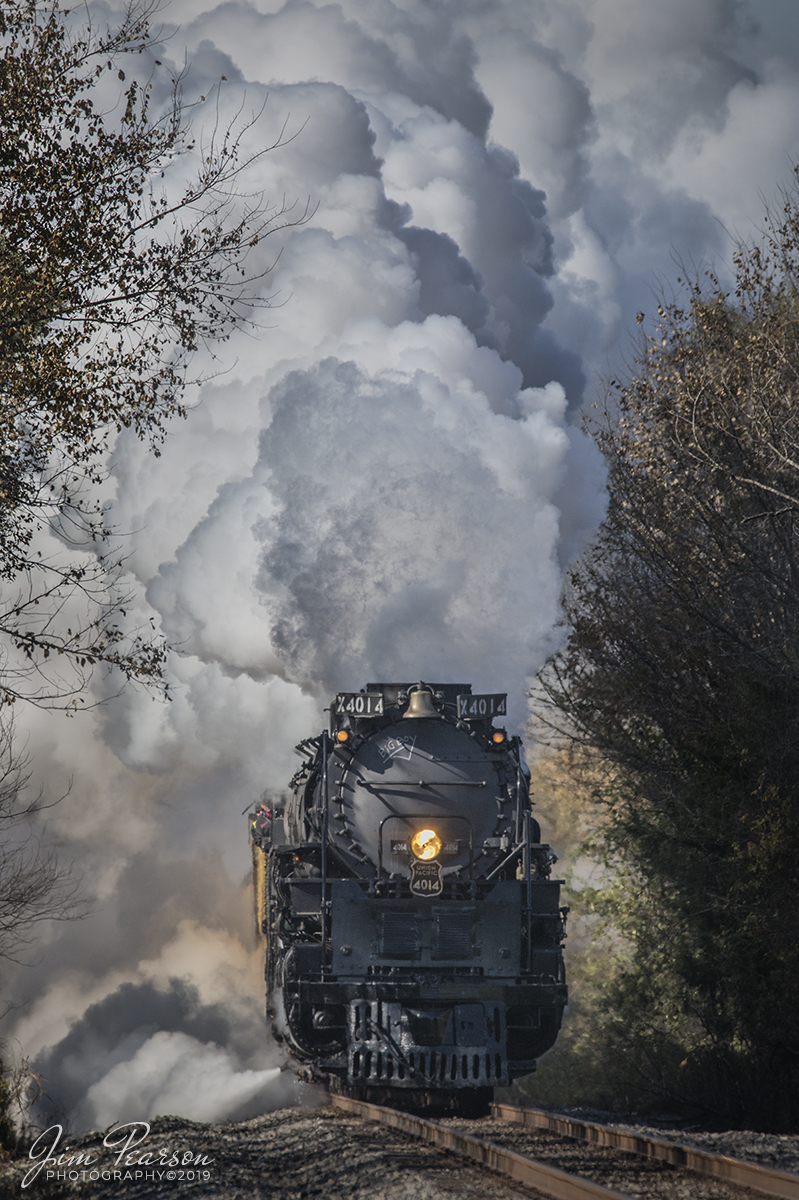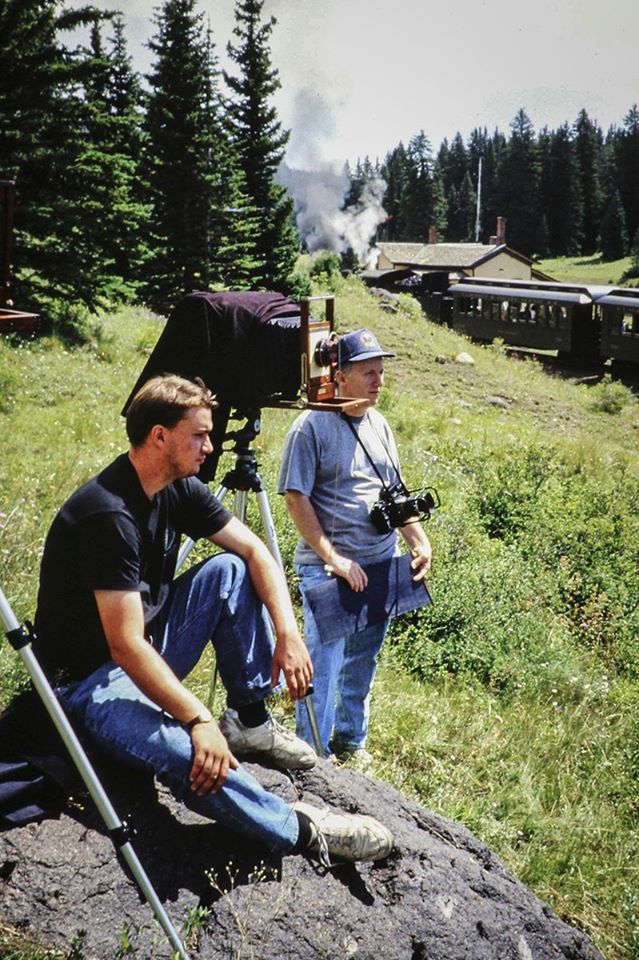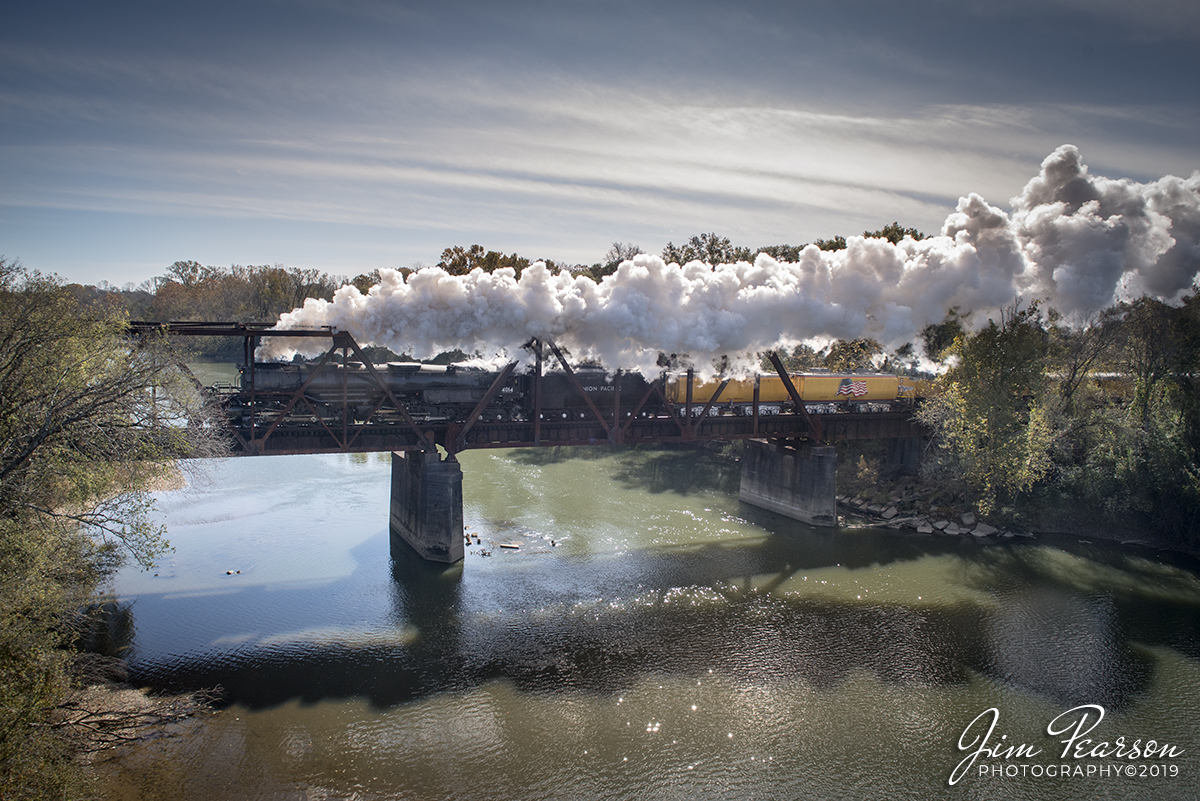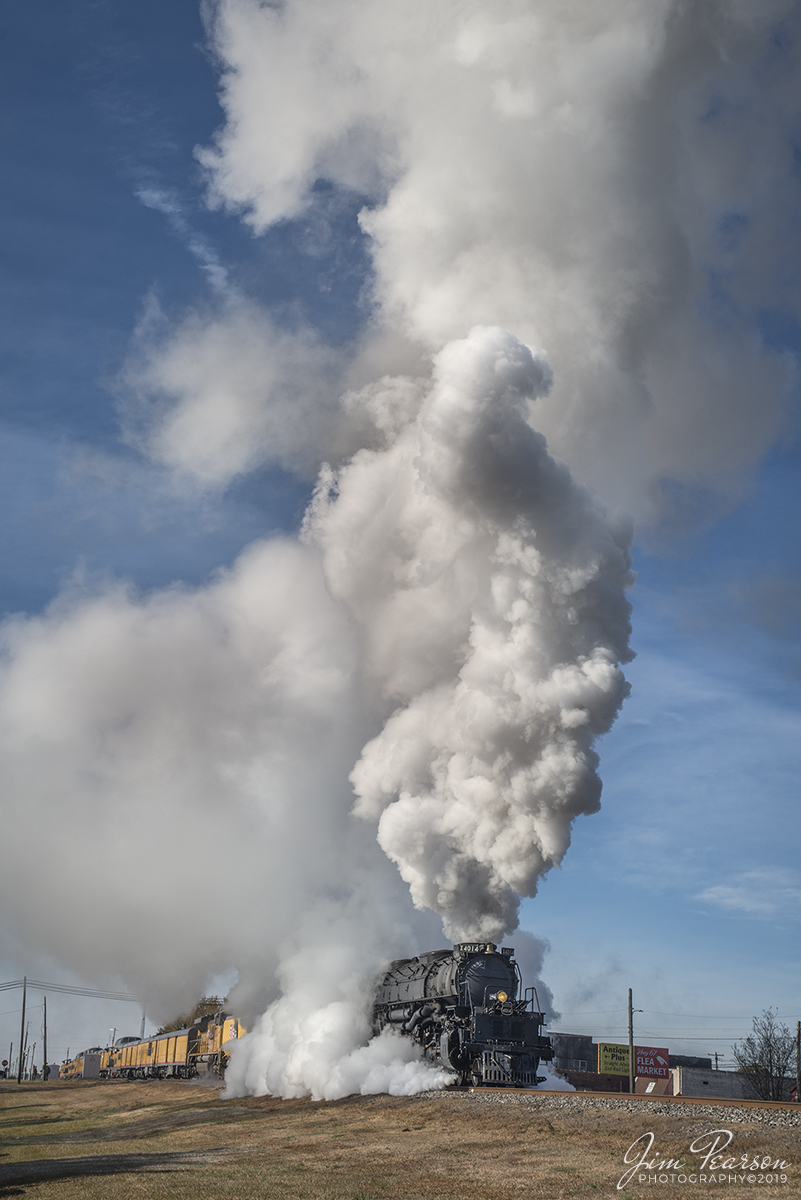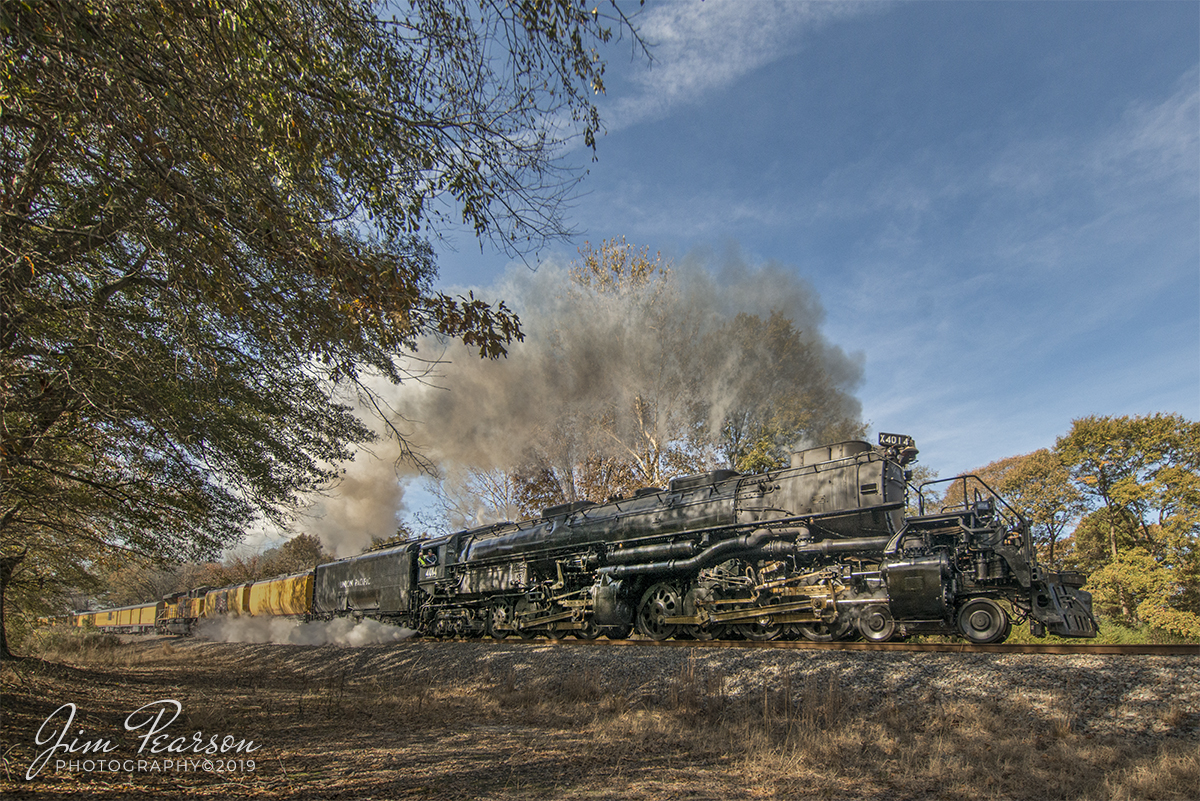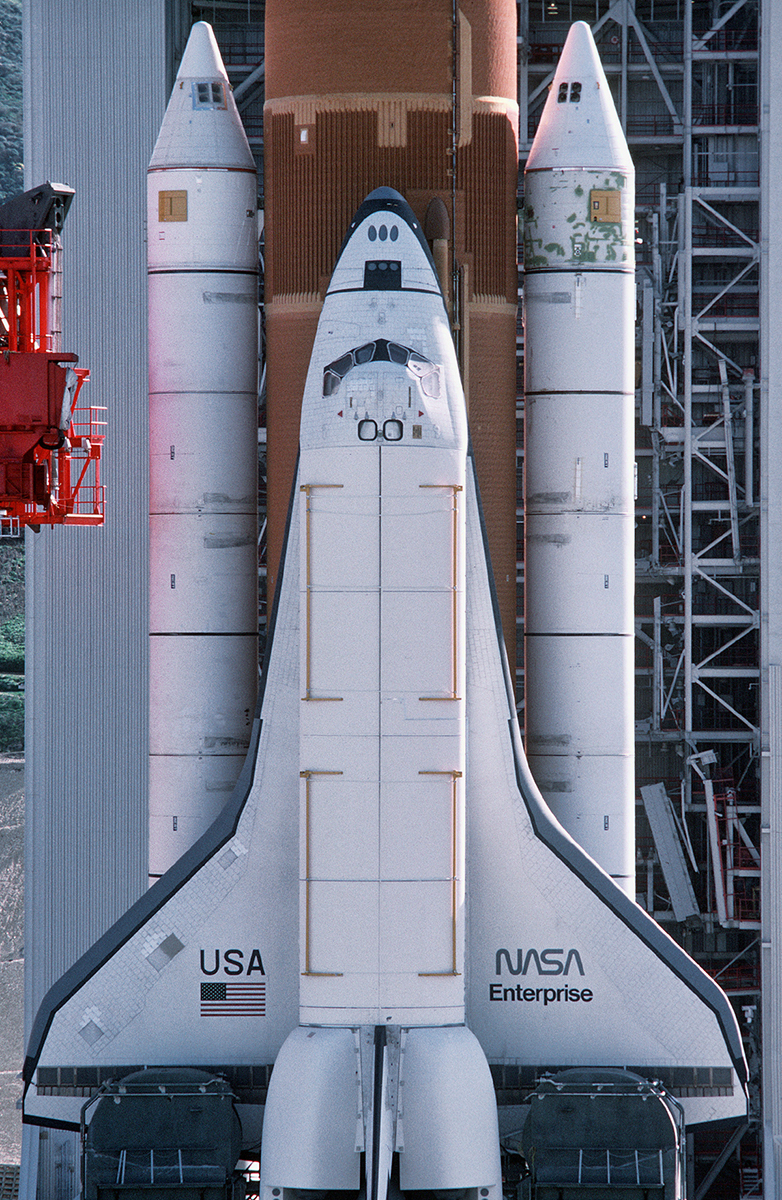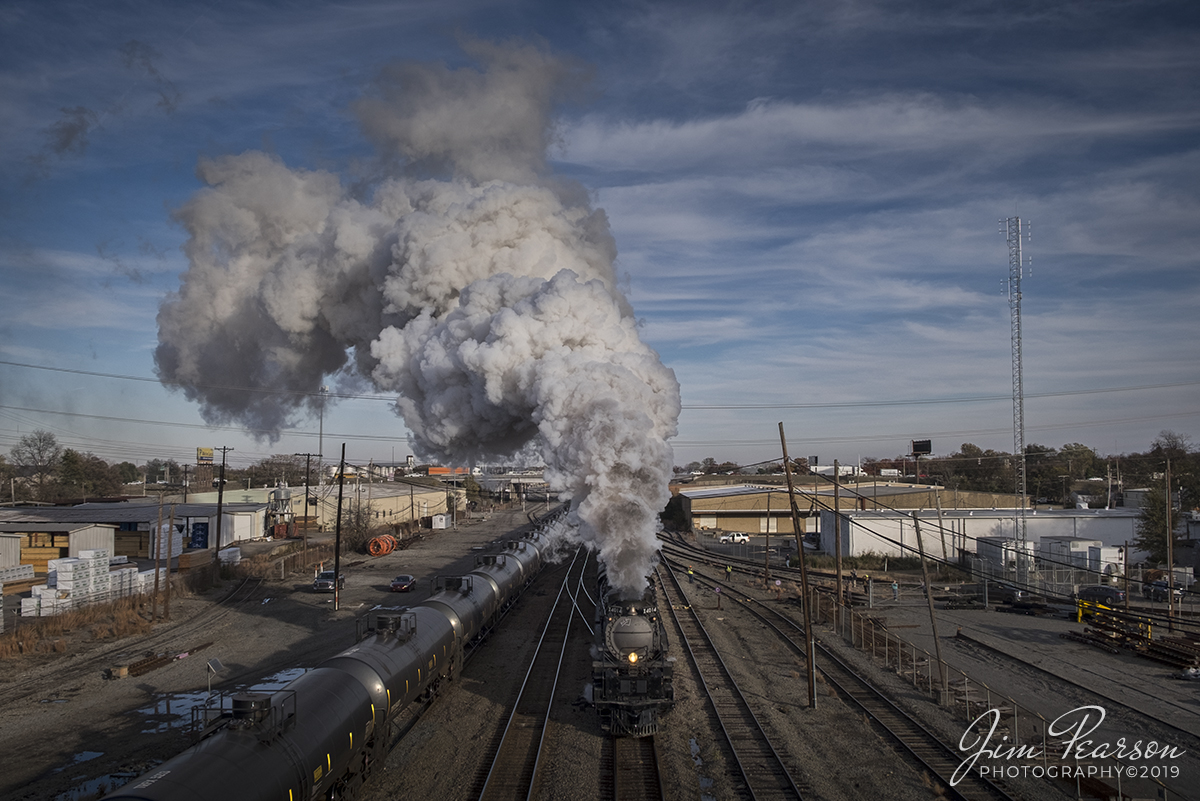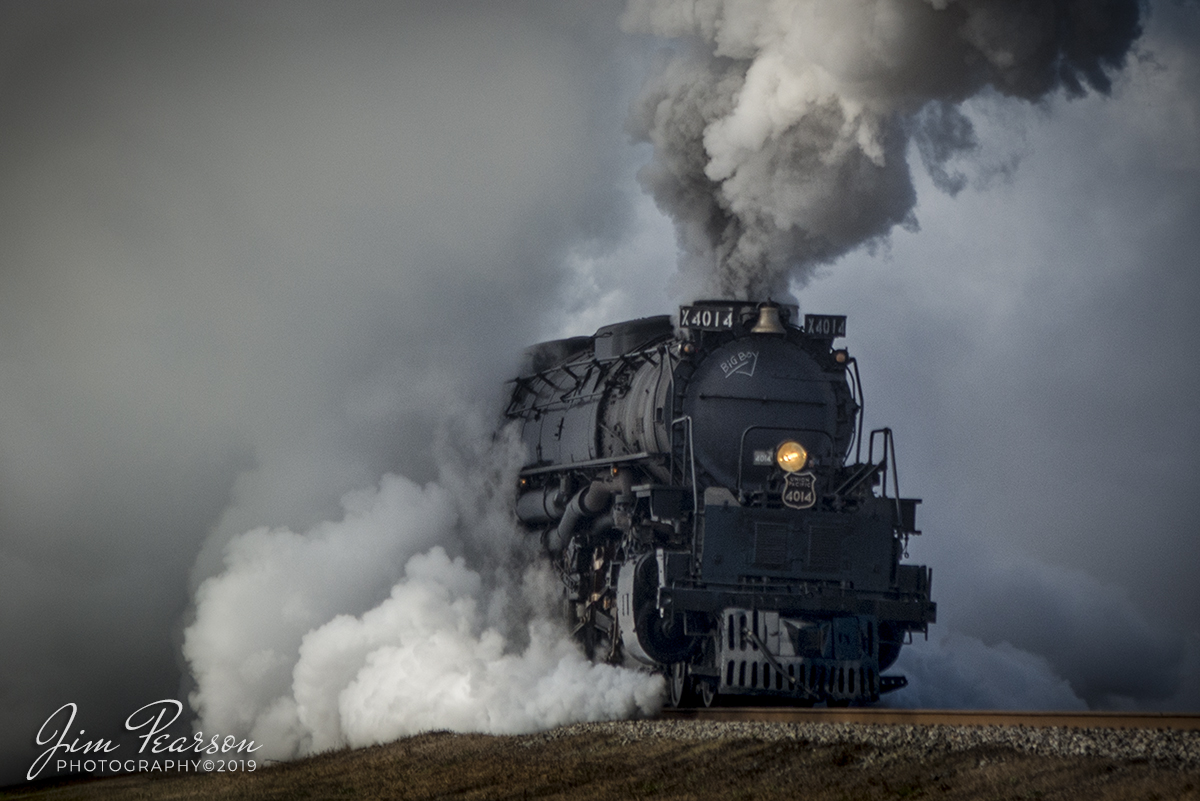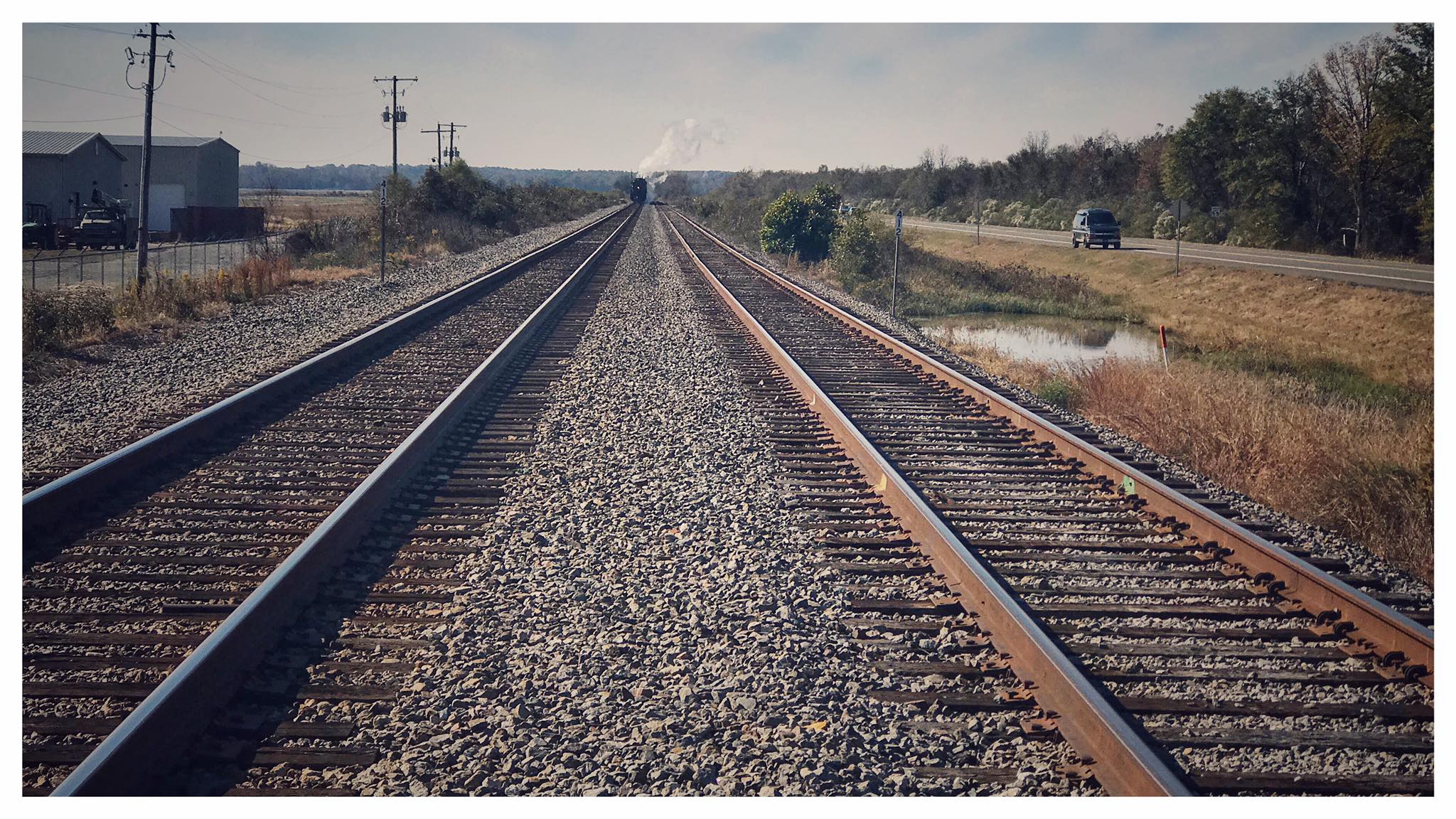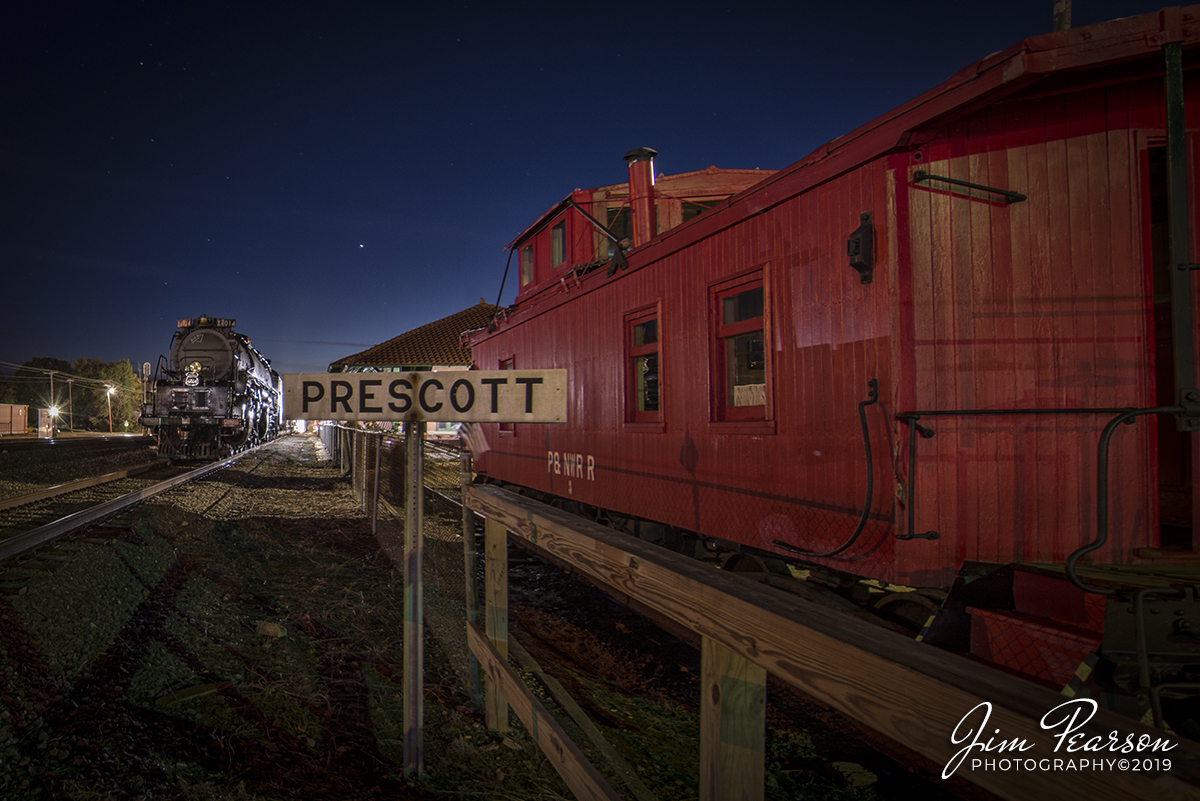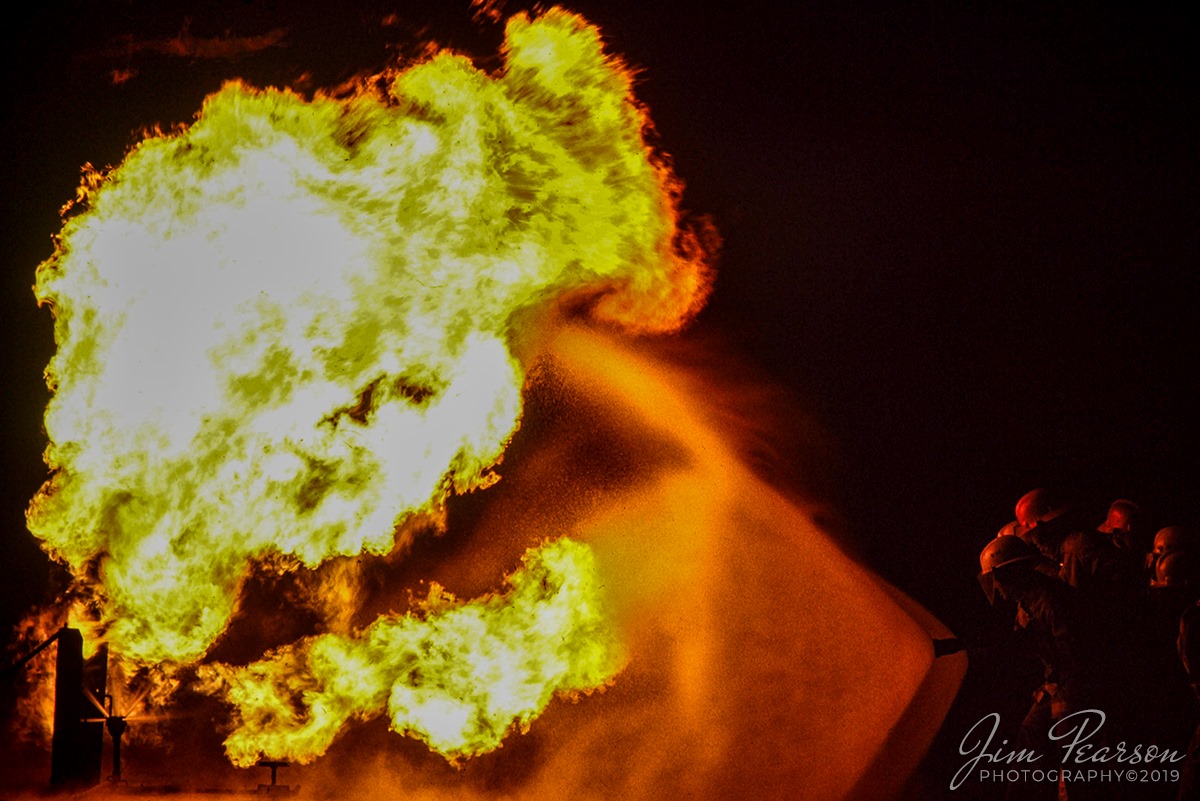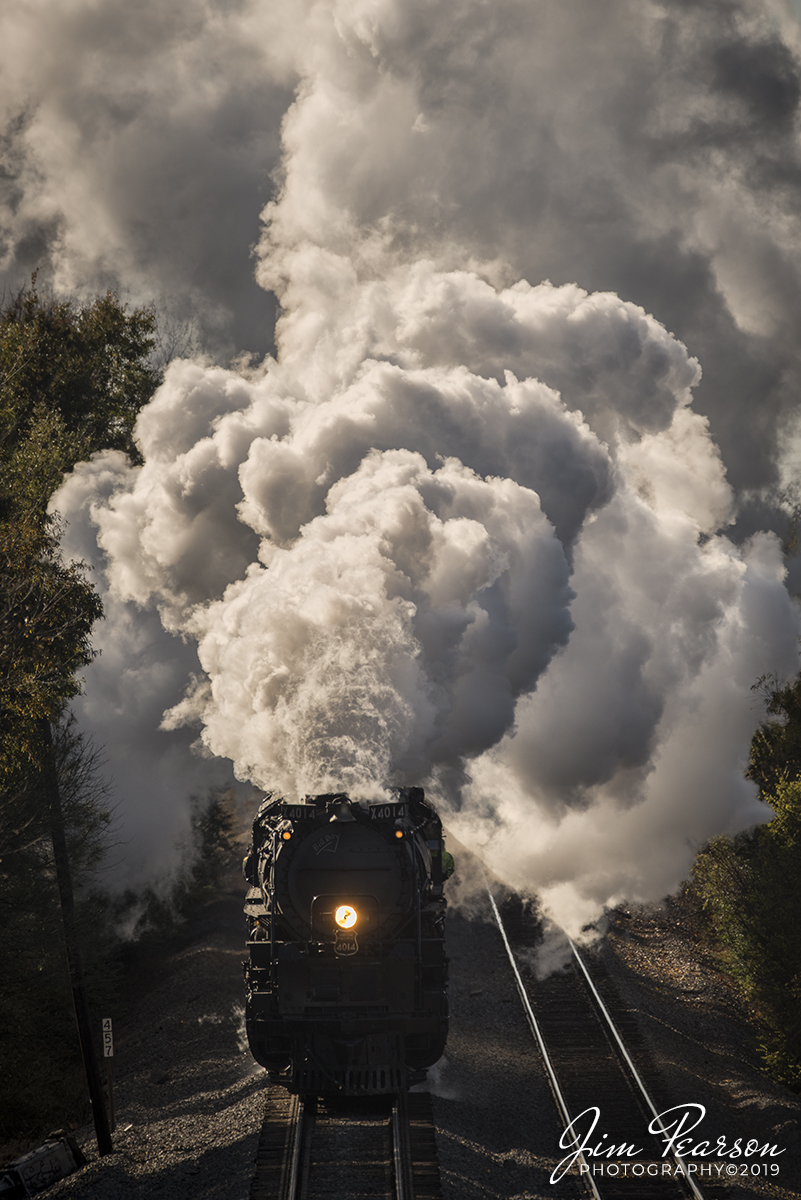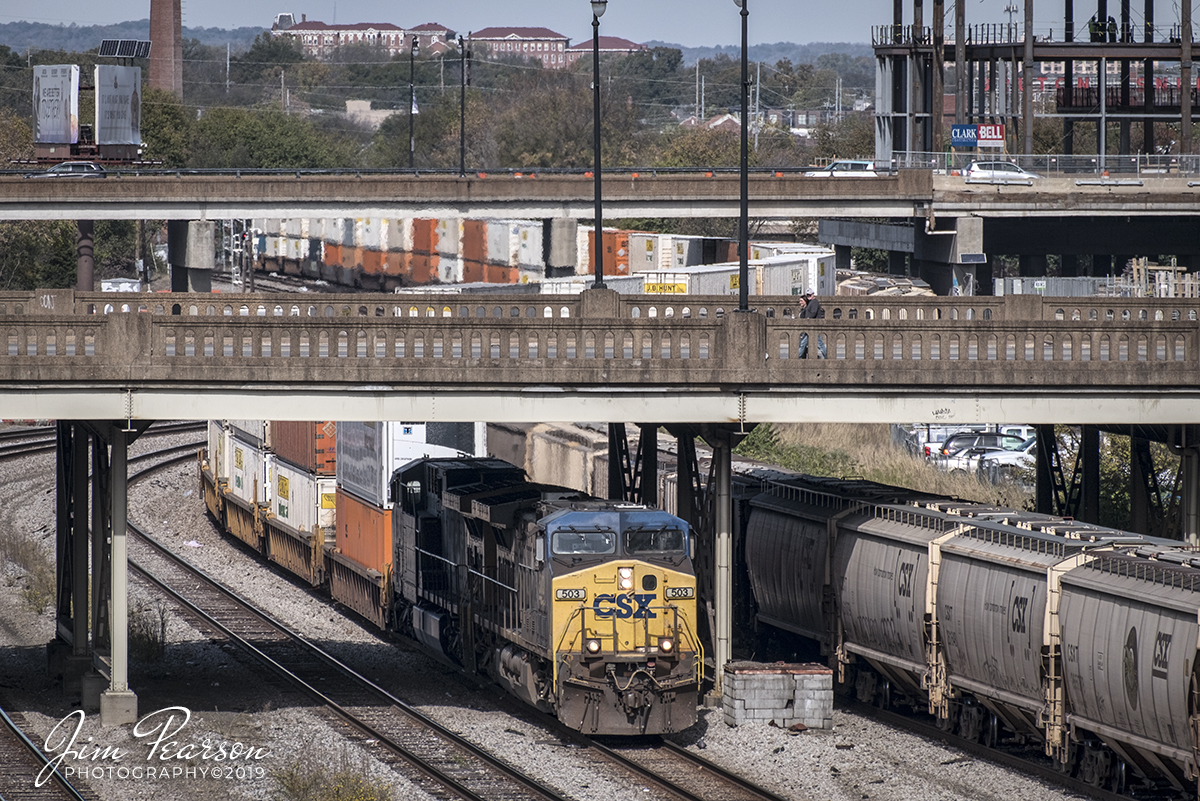November 12, 2019 – BNSF 8770 snakes a tank train past Union Station in downtown Little Rock, Arkansas as it heads north on UP’s Little Rock Subdivision.
CSX Q028 exits the CR Drawbridge…
November 26, 2019 – CSX Q028 exits the CR Drawbridge from downtown Nashville, Tennessee as it makes it’s way north on the Nashville Terminal Subdivision where it will head to Chicago, Illinois via the Henderson Subdivision.
Union Pacific’s Big Boy 4014, pulls along the siding…
November 13, 2019 – Union Pacific’s Big Boy 4014, pulls along the siding, as it heads into downtown Arkadelphia, Arkansas after waiting for a UP intermodal to pass it on the Little Rock Subdivision.
During Union Pacific’s Race Across the Southwest…
November 13, 2019 – During Union Pacific’s Race Across the Southwest UP 4014 Big Boy appears out of the steam as it pulls away from Prescott, Arkansas on its way north on UP’s Little Rock Subdivision on a beautiful and cold fall morning.
UP Steam Locomotive 4014 at Prescott, AR
November 13, 2019 – Union Pacific 2581 passes UP Steam Locomotive 4014 Big Boy, as it sits in the siding at Prescott, Arkansas, as it waits for the northbound mixed freight to pass, so the Big Boy can start it’s trip north on the Little Rock Subdivision.
Union Pacific’s 4014 Big Boy Locomotive at Little Rock, AR
November 13, 2019 – Union Pacific’s 4014 Big Boy Locomotive approaches the Cantrell Road overpass as it departs Union Station at Little Rock, Arkansas northbound on the Little Rock Subdivision on a cold, crisp fall afternoon.
I now have three 11×17 calendars available for purchase for 2020!
One is on the Union Pacific 4014 Big Boy in Black and White, another on Steam Trains I photographed in 2019 and the last is a General Train Calendar featuring some of my favorite photographs from this year. Also, there’s the 2020 West Kentucky Chapter of the NRHS Calendar available for purchase.
These are all printed on demand and a high quality 11″ x 17″ wall calendar with coil binding, white interior paper (100# weight). VISIT: http://www.lulu.com/spotlight/jimpearsonphotography to purchase today in time for the holidays and New Year!
Blast From The Past – Fall, 1980 – Here we find my on assignment…
Blast From The Past – Fall, 1980 – Here we find my on assignment taking information in the field for a caption during a military exercise in Germany called Reforger. Over the years I was part of the Combat Camera team that covered this annual exercise. The acronym stands for Return of Forces to Europe and involved the joint participation by many countries.
According to Wikipedia: Exercise Campaign Reforger (from return of forces to Germany) was an annual exercise and campaign conducted, during the Cold War, by NATO. The exercise was intended to ensure that NATO had the ability to quickly deploy forces to West Germany in the event of a conflict with the Warsaw Pact. Although most troops deployed were from the United States, the operation also involved a substantial number of troops from other NATO countries including Canada and the United Kingdom.
The Reforger exercise itself was first conceived in 1967. During the ongoing Vietnam War, the President Lyndon Johnson administration announced plans to withdraw approximately two divisions from Europe in 1968. As a demonstration of its continuing commitment to the defense of NATO and to illustrate its capability of rapid reinforcement, a large scale force deployment was planned that would deploy a division or more to West Germany in a regular annual exercise.
The first such exercise was conducted beginning on 6 January 1969. These exercises continued annually past the end of the Cold War, except for the year 1989, until 1993. Reforger 1975 marked the operational presence of the United States Marine Corps in Europe for the first time since World War I when the 2nd Marine Division’s 32nd Marine Amphibious Unit (32nd MAU) was deployed from Camp Lejeune, North Carolina, as part of that exercise. Reforger 1988 was billed as the largest European ground maneuver since the end of World War II as 125,000 troops were deployed.
Reforger was not merely a show of force—in the event of a conflict, it would be the actual plan to strengthen the NATO presence in Europe. In that instance, it would have been referred to as Operation Reforger. Important components in Reforger included the Military Airlift Command, the Military Sealift Command, and the Civil Reserve Air Fleet.
The U.S. Army also increased its rapid-reinforcement capability by prepositioning huge stocks of equipment and supplies in Europe at POMCUS sites. The maintenance of this equipment has provided extensive on-the-job training to reserve-component support units.
Union Pacific’s Race Across the Southwest was on the move again…
November 13, 2019 – Union Pacific’s Race Across the Southwest was on the move again as UP 4014 Big Boy heads through the countryside just north of Prescott, Arkansas on its way north on UP’s Little Rock Subdivision on a beautiful and cold fall morning. As you can tell the cold weather went a long way in producing beautiful plumes of steam!!
Did You Know: As if the 4000s weren’t big enough, the Union Pacific actually contemplated ordering five additional 4-8-8-4s that would be even larger. As World War II dragged on, the U.P. needed additional power on its line to Los Angeles through southwest Utah.
According to an article by historian and artist Gil Bennett (Classic Trains, Spring 2019), plans were on the drawing board to build #4025-4029. This third class of Big Boys was to measure 139 feet, 11 5/8 inches long and weighs just under 1.3 million pounds. All would be oil fired, instead of coal. The locomotive, itself, would be a foot longer than existing Big Boys. The tender was to be extended to just over 54 feet long in order to accommodate a 33,000 gal. water tank.
By comparison, #4014 and it’s tender is 132 feet, 9 7/8 inches long. Its water tank holds 24,000 gals. When the war ended in September 1945, at least a year, if not two, ahead of some predictions, the need for extra steam powered locomotives became a moot point.
The bigger Big Boy idea was dropped and the Union Pacific, like most other major railroads, concentrated on shifting to diesel power.
last From The Past – Summer, 1999 – Those were the days!…
Blast From The Past – Summer, 1999 – Those were the days! Here I’m working on shooting on the Cumbres and Toltec Scenic Railway with my 8X20″ panoramic view camera somewhere around Chama, New Mexico with my godson Dale Grant. He, his dad Norm and good friend Jose Lopez Jr. all met up at Chama for a weekend of chasing the trains.
It was an interesting camera and one of several pan cameras I’ve owned over the years during the film days. The only one I still have left is a 4×10″ Alt View, built by Patrick Alt in Los Angeles, California at the time. Now with the scarcity of film and processing chemicals it too may go up for sale here before long. Now it’s just a nice display piece as I no longer even have a darkroom setup here at home.
I was, like many, was brought up in the film age of photography and I attribute my “seeing” to what I learned over the years of shooting film and having to know what my photo was going to look like as I shot it without looking at it right afterwards, as we do today with digital.
I have to admit we have come a long way from film since the first digital cameras I used in the Air Force back in the late 1970s. In some ways it’s much better and in others not so much, but either way, shooting film I feel has made me “see” pictures better when I’m out shooting digital today.
Union Pacific 4014 Big Boy heads across the Ouachita River at Arkadelphia, Arkansas…
November 13, 2019 – Union Pacific 4014 Big Boy heads across the Ouachita River at Arkadelphia, Arkansas as it races north on the Little Rock Subdivision with it’s passenger train on UP’s Race Across the Southwest event.
Did you know: Union Pacific placed two orders for Big Boys. In 1941, they ordered 20. In 1944, five more were constructed. Their territory was basically the 435 miles between Cheyenne, Wyoming and Ogden, Utah. As a class, Big Boys ran until 1959, with some coming out of service earlier. Additionally, from 1941 to 1948, Big Boys only worked the 163 miles from Ogden to Green River, Wyoming.
From 1948 to 1959, they did not travel west of Green River. In their final years, the Big Boys only worked the 58 miles between Cheyenne and Laramie, Wyoming. Every one of the first 20 Big Boys tallied over one million miles of service. The last five had all traveled over 800,000 miles when they were retired. All this on a piece of railroad just over 400 miles long. For the record, #4017 traveled 1,052,072 miles during its life.
Union Pacific’s Race Across the Southwest…
November 13, 2019 – Union Pacific’s Race Across the Southwest was on the move again as UP 4014 Big Boy departs Prescott, Arkansas on its way north on the UP Little Rock Subdivision on a beautiful and cold fall morning. As you can tell the cold weather went a long way in producing beautiful plumes of steam!!
Did you know: The Big Boy and its tender is only 100 feet shorter than a Boeing 747! It takes a sedan, a school bus, and a diesel engine to match the length of the Big Boy and its tender. With a height of 16 feet 4 inches, and a length of 132 feet, it falls short of the 232 foot Boeing 747 only by 100 feet!
Union Pacific 4014 “Big Boy” locomotive leads it’s train…
November 13, 2019 – Union Pacific 4014 “Big Boy” locomotive leads it’s train northbound on the Little Rock Subdivision at Perla, Arkansas, during Union Pacific’s Great Race Across the Southwest tour with the restored engine.
Interesting Fact: The entire Big Boy Fleet #4000-4024 would have cost over 100 million dollars to build today!
UP ordered 20 class 4000 engines in 1941 and then 5 more in 1944 at $265,174 per engine. Adjusted for inflation this totaled a whopping $107,620,056.25, each engine individually running $4,304,802.25!
Blast From The Past – February 2, 1985 – A High angle close-up view of Space Shuttle…
Blast From The Past – February 2, 1985 – A High angle close-up view of Space Shuttle Enterprise in launch position on the Space Launch Complex (SLC) #6, commonly known as “SLICK 6”, during the ready-to-launch checks to verify launch procedures at Vandenburg AFB, California. – USAF Photo by TSgt. James R. Pearson
Union Pacific 4014 passes a northbound BNSF tank Train…
November 13, 2019 – Union Pacific 4014 passes a northbound BNSF tank Train as it heads back through the Locust Street Yard after turning its train on the Van Buren Wye at Little Rock, Arkansas. They turned the train for its display Thursday in Little Rock and Friday morning it will continue its move as it heads for its next overnight stop in Van Buren, Arkansas.
Union Pacific has billed this move as The Great Race Across the Southwest as the train is making a circle around the southwest over a six week or so period hitting Arkansas, Arizona, California, Colorado, Kansas, Missouri, Nevada, New Mexico, Oklahoma, Texas, Utah and Wyoming.
What a day!! I chased Union Pacific’s 4014 “Big Boy”…
November 13, 2019 – What a day!! I chased Union Pacific’s 4014 “Big Boy” from Prescott to Little Rock, Arkansas and couldn’t have asked for better weather! The cold really made the steam and smoke pop! Here we see 4014 as it departs Prescott early in the morning, after a slight delay to let two trains pass it. There’s just something about a steam locomotive when it pokes its nose out of a cloud of steam!
UP 4014 waits in the siding at Arkadelphia, Arkansas
November 13,2019 – UP 4014 waits in the siding at Arkadelphia, Arkansas for a northbound train to pass.
Union Pacific Big Boy 4014 sits tied down at the Prescott, Arkansas…
November 12, 2019 – Union Pacific Big Boy 4014 sits tied down at the Prescott, Arkansas depot, after its run for the day up the Little Rock Subdivision. Tomorrow morning it’ll depart at 9am CST for Little Rock where it’ll be on display till Friday morning before continuing it’s move back to Cheyenne, Wyoming.
According to Wikipedia: The Missouri Pacific Depot of Prescott, Arkansas is located at 300 West 1st Street North. It is a 1-1/2 story red brick building, with a breezeway dividing it into two sections. One section continues to be reserved for railroad storage, while the other, the former passenger ticketing and waiting area, has been adapted for use by the local chamber of commerce and as a local history museum. It was built in 1911-12 by the Prescott and Northwestern Railroad, which interconnected with the Missouri-Pacific Railroad at Prescott. The line had passenger service until 1945.
The building is now known as the Nevada County Depot and Museum. Exhibits include area settlers, railroads, and military items from World War I, World War II, the American Legion, National Guard of the United States, 1941 U.S. Army maneuvers in Prescott.
The depot building was listed on the National Register of Historic Places in 1978.
Blast From The Past – Summer 1972 – Firefighters practice…
Blast From The Past – Summer 1972 – Firefighters practice putting out a fire at a fire training academy at Hurlburt Field, Ft. Walton Beach, Fla. Hurlburt Field, also called Eglin Air Force Base, Aux Field #9, was my first duty station out of basic training where I was assigned to the 25th Special Operations Squadron. I enjoyed my tour here and won Airman of the Year for my volunteer work with the local Boys Club and photography I did for the base paper.
I’ve not found many pictures I shot there, but one of the memorable assignments I had there was to photograph inside the climatic laboratory on the main base at Eglin. It was a huge hanger where they could bring in just about anything from large aircraft, to small parts and create a cold climate for testing purposes. I can recall a time when it snowed in the hanger in the middle of summer in Florida!
According to Wikipedia: The McKinley Climatic Laboratory is both an active laboratory and a historic site located in Building 440 on Eglin Air Force Base, Florida. The laboratory is part of the 96th Test Wing. In addition to Air Force testing, it can be used by other US government agencies and private industry.
On October 6, 1997, it was added to the U.S. National Register of Historic Places. The laboratory was named a National Historic Mechanical Engineering Landmark by the American Society of Mechanical Engineers in 1987.
In 1940, the US Army Air Force designated Ladd Field in Fairbanks, Alaska as a cold-weather testing facility. Because sufficiently cold weather was not predictable and often of short duration, Ashley McKinley suggested a refrigerated airplane hangar be built. The facilities were constructed at Eglin Field.
The first tests started in May 1947. Airplanes that were tested included the B-29 Superfortress, C-82 Packet, P-47 Thunderbolt, P-51 Mustang, P-80 Shooting Star, and the Sikorsky H-5D helicopter. More recently, it has tested the C-5 Galaxy, the F-117, the F-22] the Boeing 787, and the Airbus A350 XWB
On 12 June 1971, the hangar was dedicated as the McKinley Climatic Hangar in honor of Col. Ashley McKinley, who suggested the facility and served at Eglin during its construction.
Union Pacific’s “Big Boy” 4014 puts out…
November 12, 2019 – Union Pacific’s “Big Boy” 4014 puts out a huge plume of steam in the cold November air as it departs Hope, Arkansas and heads north on the UP Little Rock Subdivision on its way to Prescott, AR where it will tie down for the night. I’m doing my first chase on the “Big Boy” today and tomorrow as it heads for Little Rock, AR.
According to Wikipedia: The Union Pacific Big Boy is a type of simple articulated 4-8-8-4 steam locomotive manufactured by the American Locomotive Company between 1941 and 1944 and operated by the Union Pacific Railroad in revenue service until 1959.
The 25 Big Boy locomotives were built to haul freight over the Wasatch mountains between Ogden, Utah, and Green River, Wyoming. In the late 1940s, they were reassigned to Cheyenne, Wyoming, where they hauled freight over Sherman Hill to Laramie, Wyoming. They were the only locomotives to use a 4-8-8-4 wheel arrangement: four-wheel leading truck for stability entering curves, two sets of eight driving wheels and a four-wheel trailing truck to support the large firebox.
Eight Big Boys survive, most on static display at museums across the country. This one, No. 4014, was re-acquired by Union Pacific and restored to operating condition in 2019, regaining the title as the largest and most powerful operating steam locomotive in the world.
CSX hot intermodal Q029 passes under Broadway Avenue…
November 4, 2019 – CSX hot intermodal Q029 passes under Broadway Avenue as it approaches Kayne Avenue on its way south on the Nashville Terminal Subdivision, at Nashville, TN with CSXT 503 leading the way.
